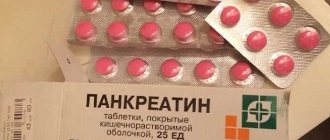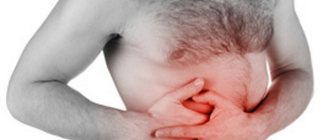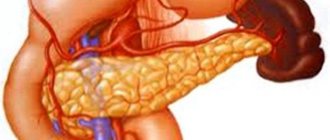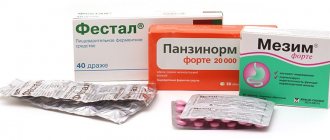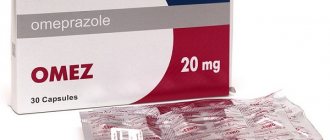Death from diseases of the pancreas, when the functionality of the organ is impaired, happens more and more every year. Statistics say that with acute pancreatitis, death occurs in 40% of cases.
Pancreatic failure can occur in patients of any gender and age. Many patients die in the first week of diagnosis of the disease during its acute course. Death often occurs with hemorrhagic or mixed types of pancreatosis.
In order to prevent the development of dangerous complications, every person should know what symptoms accompany diseases of the parenchymal organ. After all, identifying disorders at an early stage of pathology development will allow you to avoid adverse consequences and save life.
Pancreatic dysfunction: symptoms
First of all, they are associated with the digestive process:
- nausea, rarely vomiting, unpleasant belching, heartburn, rumbling;
- feces in the form of gruel several times a day. It has an unpleasant smell, undigested pieces of food, and leaves greasy marks on the toilet. sometimes constipation alternates with diarrhea;
- pain at the location of the organ, under the left rib. The pain becomes stronger if you do not adhere to a diet, eat fatty, smoked, or hotly seasoned foods; increased pain can also occur during nervous stress or stress;
- weight loss due to impaired absorption;
- decreased working capacity, weakness, drowsiness, hair loss, rash, weak nails;
- disturbance of intestinal microflora.
First signs
Signs of pancreatic disease begin with disruption of the structure and physiological functioning.
It all starts with an inflammatory process, during which many problems occur, in particular swelling and pain. Everything is located depending on the location of the gland lesion, most often it is the costal arch (if the head is on the right, the tail is on the left, and the body is in the middle). When the entire gland is affected, the pain is of a girdling nature; in particular, the patient notes that he was hit like a dagger. It sends everything to the back, as well as to the spinal column; such signs are associated with the peculiarities of the innervation of the organ. A feature of pancreatic disease is that the pain constantly increases.
Skin sensitivity also increases during an attack of the disease.
Next, the person is bothered by nausea and vomiting, which appears reflexively. A person vomits the food he has just eaten; after the attack, the relief is not significant.
An insufficient amount of enzymes causes digestive disorders; a person does not tolerate honey, mushrooms, tomatoes and sweets.
Due to the large amount of fat, the stool is shiny, which can be seen upon external examination. When you try to wash it off the surface of the toilet, this is not always possible. This happens during illness due to the lack of lipase. It is this enzyme of the gland, together with bile, that promotes the breakdown of fats. A person has frequent stools, up to 4-5 times during the day.
The abdomen is swollen, and especially during an attack, the person is bothered by colic. Fatty and smoked foods bring nausea and heaviness in the stomach.
When the pancreas is not functioning properly, nutrients are not absorbed in full, which is why a person loses weight; at the initial stage of the disease, appetite is preserved, but later it disappears.
Due to poor absorption of nutrients, in particular fats and vitamins, signs of vitamin deficiency appear, in particular vitamins A, K, D. The first symptoms that attract attention in case of vitamin A deficiency are dry skin and impaired vision; in case of D deficiency, brittle bones and muscle cramps. A lack of vitamin K causes poor blood clotting. Proteins that are poorly digested during illness cause anemia and vitamin B12 deficiency.
With destructive pancreatitis, when destruction of pancreatic tissue occurs, the clinic is completely different. The most common cause is the use of alcoholic beverages. The signs are that the organ tissue is quickly destroyed, causing severe pain. In addition, pancreatic enzymes, of which a lot have already accumulated, begin to irritate the peritoneum (the membrane lining the internal organs), as a result of which it becomes inflamed, causing signs of a disease such as peritonitis.
If signs of peritonitis appear, the stomach hurts greatly, you cannot touch it, and it resembles a board. It is necessary to urgently surrender to doctors and perform immediate surgery, otherwise death is inevitable.
Causes
A disorder of the pancreas most often occurs due to chronic pancreatitis, which develops as an independent disease.
Disruption of the normal functioning of the pancreas occurs due to:
- improper diet;
- eating fatty, fried foods;
- lack of proteins and vitamins;
- untreated cholecystitis, cholelithiasis, bile duct dyskinesia, reflux of bile into the pancreatic duct;
- drinking large amounts of alcohol;
- gastritis;
- duodenitis;
- stomach ulcer.

A patient with a tendency to diseases of the digestive tract is the first candidate for the occurrence of pancreatic dysfunction, which will manifest itself sooner or later. That is why such patients need to be careful with nutrition and emerging disorders, and find out the reasons. You need to behave very carefully with alcohol, because it is the most important aspect of the disorder.
We also recommend viewing: Comparison of CT and MRI in the pancreas
How do pancreatic problems manifest themselves?
Pathologies of the pancreas can be inflammatory in nature, then pancreatitis is diagnosed, which can be of different types.
Table. Main types of pancreatitis
| View | Causes |
| alcoholic | alcohol abuse |
| drug | chaotic or prolonged use of medications |
| calcined | excess salt in the body |
| biliary | a consequence of the formation of stones in the bile ducts |

But any gland problem makes itself felt by exacerbation and acute, sudden pain, which can be localized:
- In the hypochondrium (left and right);
- In a stomach;
- In the navel area;
- In the stomach.
The pain can radiate to the lower back, back, joints, even to the facial nerve and jaw.
If the pain is mild, then perhaps problems with the pancreas are at an early stage. Or have already become chronic.
Important! No pain can be tolerated. If it occurs, call an ambulance.
Drugs to treat illness
The first thing you need to do is abstain from food and give your pancreas rest.
The following medications are prescribed:
- omez, pantoprazole, ranitidine, quamatel - reduce gastric secretion. Gastric juice stimulates the production of pancreatic secretions;
- no-spa, platifillin, papaverine, duspatalin are antispasmodic drugs that are prescribed for severe pain;
- urolesan - prescribed if there is pathology of the gallbladder and ducts; it is plant-based and has a beneficial effect on spasms in the gallbladder and sphincter;
- Mezim, Creon - prescribed for insufficient amounts of secreted enzymes.

Omeprazole + pancreatin is a standard doctor’s prescription for chronic pancreatitis, which has become the main cause of pancreatic dysfunction. The course of treatment can reach 90 days of continuous use. Application scheme:
- omeprazole – 20 mg in the mornings or evenings;
- Pancreatin – 0.5-1 tablet with meals. The dose depends on the degree of enzyme deficiency.
Important. During the period of relief of symptoms of pancreatic dysfunction, patients are sent to medical resorts in Kislovodsk or Essentuki.
If there are signs of pancreatic dysfunction, doctors recommend drinking warm still water from Essentuka or Borjomi. You need to drink up to 1.5 liters per day.
How to determine that you have problems with the gland?
Symptoms will help you understand that you have problems with the gland. Nausea and vomiting begins. Then the temperature rises, and then diarrhea begins - foamy stool with undigested food particles.
The patient's appearance becomes:
- Pale;
- Exhausted;
- The face is covered with perspiration.
Breathing is intermittent, pulse is high - more than 100 beats per minute. Over time, your blood pressure may drop. From severe pain, a person can faint, lose consciousness, shock and collapse develop.
Attention! A painful symptom will be the main reason for visiting a doctor, where an extensive diagnosis will be carried out.
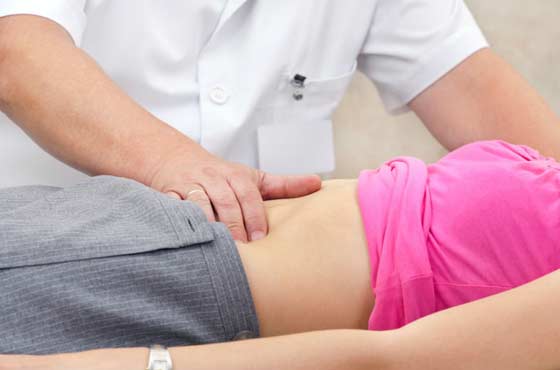
Problems with the pancreas have symptoms similar to other types of diseases of the gastrointestinal tract, liver, and biliary tract. The same pain can occur in the abdominal area with a huge number of diseases.
Another article on this topic: Symptoms and treatment of chronic pancreatitis (ICD 10 code)
Nausea and vomiting are also signs of a large number of diseases, including common poisoning. Fever - this symptom accompanies diseases of any nature and not only the gastrointestinal tract.
Therefore, a differential diagnostic approach, that is, excluding other diseases, will help to recognize problems with the pancreas.
When diagnosing pancreatitis, doctors must make sure that there is no danger to the patient’s life and exclude such complex and serious diseases as intestinal obstruction, perforation of a gastric or duodenal ulcer, destructive cholecystitis and even myocardial infarction. All these diseases have similar symptoms, so the doctor begins to carry out a set of diagnostic procedures that will definitely exclude pathologies that are dangerous at this moment in life.
To do this, the doctor will prescribe:
- X-ray – scanning of the peritoneum with x-rays;
- Ultrasound – scanning of organs using ultrasound;
- Laparoscopy is an examination of the peritoneum through punctures and insertion of an endoscope.

These methods help to clearly recognize organ pathologies and separate pancreatic disease from other diseases with similar symptoms:
- Stomach ulcers;
- Appendicitis;
- Duodenal ulcers;
- Food intoxication;
- Gallstone disease;
- Acute dilatation of the stomach;
- Vein thrombosis, etc.
In the acute form and attack, all symptoms manifest themselves very strongly. Therefore, it is advisable to give the patient an anesthetic drug and refer him for differential diagnosis to exclude other forms and types of diseases. In addition, the doctor conducts an external examination of the patient. For experienced doctors, even the appearance and firmness or swelling of the abdomen indicate a presumptive diagnosis. The doctor also examines the external skin and monitors the patient’s behavior.
With pancreatitis, a person behaves restlessly , and, for example, with a stomach ulcer, he lies motionless and is afraid to move. A professional doctor will see every nuance to make a correct diagnosis. After which the patient is prescribed laboratory tests, which will also characterize the patient’s condition and allow a professional gastroenterologist to determine the disease. Laboratory tests can play a decisive role in differential diagnosis.
So, if there are two diagnoses in question: pancreatitis and appendicitis, then blood and urine tests are completely different in composition. But laboratory diagnostics do not play a major role when there are doubts about diagnosing, for example, duodenal ulcers and pancreatitis. Then the blood, urine and stool tests are approximately identical. All questions are resolved by X-ray, ultrasound, CT, MRI.
In the acute form, differential diagnosis must be carried out quickly, since the symptoms are suitable for those diseases that require urgent surgery.
When pancreatitis is confirmed, the second stage of differential diagnosis begins - clarifying what type of pathology: necrotic or infected; what is the stage, form, etc.
Important! The entire range of diagnostic measures is aimed at making an accurate diagnosis. After all, as you know, the correct diagnosis is 50% of successful treatment.
Diet food
To normalize the functioning of the pancreas, you need to adhere to a certain diet. First, observe a short fast for 24 hours, and then eat according to diet No. 5. The food should not be too hot.
You need to eat 4-6 times a day and consume small amounts of food at one time. At the same time, there should be a calm atmosphere, the person should not rush anywhere. Every piece of food is chewed carefully.
List of permitted products:
- meat – chicken, turkey, rabbit, veal;
- fish - low-fat varieties, as well as crayfish and shrimp;
- fat – sunflower, olive, corn oil;
- dairy products – low-fat cottage cheese, kefir, yogurt, yogurt; low-fat cheese; milk in small quantities, fat content 2.5;
- egg – one or two per week, cooked as an omelet in the oven;
- fruits and vegetables - baked zucchini, carrots, apples, melons, pumpkin, bananas, as well as compotes made from them; apricots, peaches;
- potatoes – baked, boiled or mashed;
- bread – white, not today’s bread, can be cooked in a toaster;
- porridge – rice, oatmeal, semolina, buckwheat, possibly with milk;
- sweets - sponge cake, fat-free cake, fruit pies, cookies with oatmeal, honey, small quantities of caramels;
- drinks – tea, still water, weak coffee with milk, jelly.
We also recommend viewing: Is a patient’s life possible without a pancreas: recommendations from doctors

Important. All dishes must be boiled, stewed, baked.
What should be excluded from the diet if you have pancreatic dysfunction:
- meat - lamb, pork, duck, goose, fatty meats, as well as all types of sausages;
- fish – all fatty varieties, as well as caviar;
- fat – lard, animal fat, margarine, butter, mayonnaise;
- dairy products - all fatty types of dairy products, as well as large amounts of milk;
- egg – fried, boiled;
- vegetables and fruits - cabbage in any form, radishes, radishes, sorrel mushrooms, legumes;
- potatoes – fried, fatty;
- bread – black, with bran, as well as today’s bread;
- porridge – pearl barley, wheat;
- sweets – cream sweets, fresh pastries, chocolate products, ice cream;
- drinks – alcohol, carbonated drinks, strong coffee, cocoa.
Important. Anything fried in oil or over a fire is prohibited for consumption.
Abdominal pain
Patients with pancreatitis experience severe abdominal pain that radiates to the back. The pain is felt directly under the chest. Initially, the pain is tolerable, but if left untreated, inflammation of the pancreas can lead to excruciating pain that can only be relieved by administration of morphine. The pain may be worse after eating high-fat foods. The pain can become very intense when you lie on your back or bend forward. On the other hand, in some cases of acute pancreatitis, patients do not feel much pain; this is more common if the patient is diabetic or has kidney disease.
Text continues after advertisement
Nausea is a common symptom that accompanies pancreatitis and may be secondary to pain or due to changes in digestion. To cope with this, patients should drink plenty of water, avoid alcohol and excessive food intake, especially limiting fats. Nausea may be severe enough to cause dry vomiting.
Preventative methods for pancreatic dysfunction
As already mentioned, pancreatic dysfunction is a disruption of the normal functioning of the digestive system.
In order not to be subject to disturbances in the functioning of the pancreas, you need to pay attention to certain symptoms in a timely manner, not to trigger existing disorders in the digestive tract, and monitor your digestion and nutrition. The latter must be balanced and rational. Food should not be fatty, smoked, or cooked in oil. Every person's diet should consist of fruits and vegetables. You can also start taking vitamins to enrich your body. Eating should be calm. Food must be chewed thoroughly and taken according to the schedule. It is better to eat more often, but less. This is the best option for a person with an increased risk of pancreatic dysfunction.
Important. Moderate exercise will also be useful, which will not only tone the entire body, but also relieve stress.
External manifestations
Acute inflammation of the gland can be suspected simply by looking at a person. His pain will be severe, often the symptoms are characterized by a sitting position bending forward. On the left side during an exacerbation of the disease is generally not realistic. As already mentioned, the pain that encircles during an attack is located on the left and is very pronounced.
The patient is accompanied by vomiting, which does not bring him relief from inflammation of the pancreas; it is acidic, and impurities in it may be blood or bile. Temperature also increases during illness.
Disruption of the gland does not affect the spine in any way, but the pain radiates into it. In case of exacerbation of the pancreas, palpating it will not cause pain, unlike osteochondrosis, in which there are no manifestations from the gland.
Summarize
Pancreatic dysfunction is a disease that needs to be treated with special attention. If digestive problems occur, there is no need to wait or self-medicate, you should immediately contact a specialist.
We also recommend viewing: Causes and treatment of pancreatic atrophy
The gastroenterologist will prescribe treatment and a diet that must be followed strictly. Be very careful about suspicious symptoms in children.
If dysfunction is not treated, serious complications and poor health of the body can result. Compliance with the prescribed treatment and diet will lead to complete recovery.
What to do in such a situation?
If there are any problems with the pancreas, you should under no circumstances hesitate. The person must be urgently hospitalized or shown to a doctor: a therapist, gastroenterologist or surgeon.
In the remission stage, when it seems that everything is in order with the gland, you will still need to completely give up alcohol and follow a diet. If pancreatic fat is impaired, proteins are increased, meat, cottage cheese and fish are recommended. If you have problems with the gland, you should not eat spicy foods or coarse plant fiber found in apples, cabbage or oranges. Otherwise, you should adhere to a special diet and doctor’s recommendations.
Author : Ivanov Alexey Sergeevich, especially for the site Moizhivot.ru
Smelly chair
An early warning sign of pancreatitis is pale, floating, or smelly stool. Because digestive enzymes from the pancreas are not produced enough or cannot reach the small intestine, proper digestion of food, especially fatty foods, is not possible. This results in stool that is loose and smelly. Some patients even see dark, tarry stools and this is usually due to bleeding into the intestines from the pancreas, ducts or adjacent structures. Doctors believe this sign is an early concept given by the body, but it is often overlooked.
The bottom line is that patients should seek medical help immediately if they notice severe, unexplained abdominal pain, vomiting, or fatigue that does not improve with pain medications. Diagnostic examination and treatment of pancreatitis should be carried out immediately. Doctors' main goal should be to monitor symptoms and maintain body function so that inflammation of the pancreas can subside.


